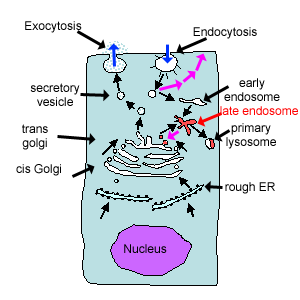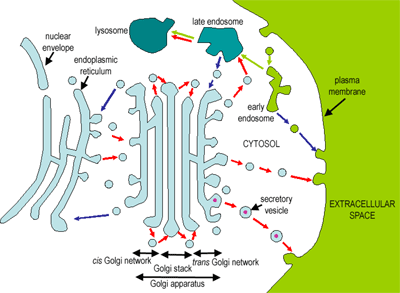Endo- and Exocytosis

Eukaryotic cells are able to take up macromolecules from the outside of the cell by a process called endocytosis, and to transport macromolecules to the outside of the cell by a process called exocytosis, as shown in the diagram.
In endocytosis: the endocytosed macromolecules are transported inside the cell in a vesicle called an endosome. (These include macromolecules in the plasma membrane itself). Endosomes fuse fuse to form early endosomes. The early endosomes fuse with vesicles from the Golgi to form late endosomes. New vesicles called lysosomes, bud off from the late endosome. The lysosomes are bags of hydrolytic enzymes, which 'digest' macromolecules. They contain around 40 different types of hydrolytic enzymes - proteases, lipases, glycosidases, etc, and they work in an acid environment. in which the proteins are broken down. Some molecules/proteins are retrieved (pink arrows), either from the endosomes and sent back to the plasma membrane for re-use (pink arrows), from late endosomes and sent to the Golgi (pink arrow).
In exocytosis, proteins made in the rough ER are transported to the Golgi, sorted, packaged, and sent to the plasma membrane in exocytic vesicles.

This diagram is another representation of the pathways for endo- and exo-cytosis, in which 'retrieval' pathways are shown in blue.
Three routes for endocytosis:
There are three routes for endocytosis - uptake of macromolecules at the plasma membrane, degradation of intracellular organelles (autophagy) and uptake of cells/microorganisms - phagocytosis. All of these forms of endocytosis require special receptor molecules at the plasma membrane.
Phagocytosis (cellular eating)
This is a specialised form of endocytosis, that is usually only carried out by specialised cells, for example, macrophages and other white blood cells . Micro-organisms, or cell debris are taken up into large vesicles, that are bigger than 250nm in diameter. The particles that are going to be phagocytosed have to bind to the membrane first through receptors in the membrane. For example, bacteria are bound to white blood cells when antibodies on the bacteria are recognised by special Fc receptors on white blood cells. The white blood cells then extend fine processes that surround the bacterium. (See movie.)
This phase photograph shows a macrophage that is just about to ingest a particle.
Pinocytosis (cellular drinking)
This is sometimes used to mean fluid-phase endocytosis, when the vesicles are smaller than 150nm in diameter. This again requires receptors, and more than 25 different types of receptor are known. For example, most cells take up cholesterol through receptor mediated endocytosis. Cholesterol is transported in blood bound to proteins called low-density lipoproteins (LDL). The cells have receptors for cholesterol called LDL receptors. When LDL binds to the receptors, endocytosis is initiated. Defects in this pathway can result in high blood cholesterol levels, and a predisposition to atherosclerosis, heart disease, and early death from coronary heart disease.
As the endocytic vesicles invaginate into the cell, the membrane is surrounded by a network of proteins, including clathrin, which form a cage around the vesicle (called clathrin coated pits).
Cells also use this process to continually recycle their plasma membrane. The rate at which they do this varies from cell to cell, but a macrophage can ingest 25% of its own volume of fluid per hour (3% of it's plasma membrane per minute). Fibroblasts endocytose at a lower rate than this. This continual endocytosis, which removes plasma membrane, is balanced by continual exocytosis, so that the cell stays the same size.
Synaptic transmission involves exocytosis (to release neurotransmitter) and endocytosis (to recover plasma membrane etc).
Macropinocytosis
Finally, some cells can take up fluid by a process called 'macropinocytosis'. In this case, the vesicles are large - greater than 250nm, but receptors do not seem to be required.